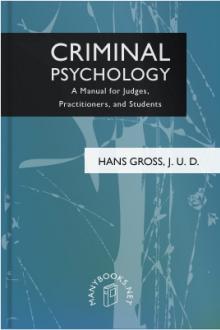Criminal Psychology by Hans Gross (best book recommendations .TXT) 📕

- Author: Hans Gross
- Performer: -
Book online «Criminal Psychology by Hans Gross (best book recommendations .TXT) 📕». Author Hans Gross
but not necessarily, present river. Or perhaps we see a church spire, and possibly near it the roof of a house rises above the trees; then we are inducted into having seen a village, although there really are visible only the church and the house.
These illusions again, I must repeat, are of no importance if they are at all doubted, for then the truth is ascertained. When, however, they are not doubted and are sworn to, they cause the greatest confusion in trials. A bar-room quarrel, a swung cane, and a red handkerchief on the head, are enough to make people testify to having seen a great brawl with bloody heads. A gnawing rat, a window accidentally left open through the night, and some misplaced, not instantaneously discovered object, are the ingredients of a burglary. A man who sees a rather quick train, hears a shrill blowing of the whistle, and sees a great cloud, may think himself the witness of a wreck. All these phenomena, moreover, reveal us things as we have been in the habit of seeing them. I repeat, here also, that the photographic apparatus, in so far as it does not possess a refracting lens, shows things much more truly than our eye, which is always corrected by our memory. If I permit a man sitting on a chair to be photographed, front view, with his legs crossed and stretched far out, the result is a ludicrous picture because the boots seem immensely larger than the head of the subject. But the photograph is not at fault, for if the subject is kept in the same position and then the apparent size of head and boot are measured, we get accurately the same relation as on the photograph. We know by experience how big a head is. And hence, we ordinarily see all relations of size in proper proportion. But on the photograph we can not apply this “natural” standard because it is not given in nature, and we blame the camera.
If, in a criminal case, we are dealing with a description of size, and it is given as it is known from experience, not as it really appears, then if experience has deceived us, our testimony is also wrong, although we pretend to have testified on the basis of direct sense-perception.
The matter of after-images, probably because of their short duration, is of no criminalistic importance. I did once believe that they might be of considerable influence on the perception of witnesses, but I have not succeeded in discovering a single example in which this influence is perceptible.
On the other hand, the phenomenon of irradiation, the appearance of dark bodies as covered with rays of light by adjacent luminosities, <p 443>
is of importance. This phenomenon is well-known, as are Helmholtz’s and Plateau’s explanations of it. But it is not sufficiently applied. One needs only to set a white square upon the blackest possible ground and at the same time a similar black square of equal size on a white ground, and then to place them under a high light, to perceive how much larger the white square appears to be. That such phenomena often occur in nature need not be expounded. Whenever we are dealing with questions of size it is indubitably necessary to consider the color of the object and its environment with respect to its background and to the resulting irradiation.
Section 100. (3) Auditory Illusions.
From the point of view of the criminalist, auditory illusions are hardly less significant than visual illusions, the more so, as incorrect hearing is much more frequent than incorrect seeing. This is due to the greater similarity of tones to each other, and this similarity is due to the fact that sound has only one dimension, while vision involves not only three but also color. Of course, between the booming of cannons and the rustling of wings there are more differences than one, but the most various phenomena of tones may be said to vary only in degree. For purposes of comparison moreover, we can make use only of a class of auditory images on the same plane, e. g., human voices, etc. Real acoustic illusions are closely connected with auditory misapprehension and a distinction between these two can not be rigorously drawn. A misapprehension may, as a rule, be indicated by almost any external condition, like the relations of pitch, echo, repetition, false coincidence of waves of sound, etc.
Under such circumstances there may arise real illusions.
The study of auditory illusions is rendered especially difficult by the rarity of their repetition, which makes it impossible reliably to exclude accidents and mistakes in observation. Only two phenomena are susceptible of accurate and sufficient study. For three summers a man used to ride through the long street in which I live. The man used to sell ice and would announce himself by crying out, “Frozen,” with the accent on the Fro. This word was distinctly audible, but if the man came to a definite place in the street, there were also audible the words “Oh, my.” If he rode on further the expression became confused and gradually turned into the correct, “Frozen.” I observed this daily, got a number of others to do so, without telling them of the illusion, but each heard <p 444>
the same thing in spite of the distinct difference between “frozen,”
and “oh, my.”
I made a similar observation at a bicycle school. As is known, beginners are able frequently to ride by themselves but need help in mounting and dismounting their machines. To do so they call a teacher by crying out: “Herr Maier.” At a certain place this sound would seem distinctly to be “mamma.” I was at first much surprised to hear people of advanced age cry cheerfully, “mamma.”
Later I discovered what the word really was and acquaintances whose attention I called to the matter confirmed my observation.
Such things are not indifferent, they show that really very different sounds may be mistaken for one another, that the test of misunderstandings may often lead to false results, since only during the test of an illusion are both auditor and speaker accurately in the same position as before. Finally, these things show that the whole business of correcting some false auditions is very difficult. Yet this work of correction may be assumed to be much more easy with respect to hearing than with respect to seeing. If, e. g., it is asserted that the revolver has been seen somewhere, and if it has been known that the sight was impossible, it becomes just as impossible, almost, to determine what the object seen really was. In the rarest cases only will it be something altogether similar, e. g., a pistol; most of the time it will be an object which could not be inferred from no matter what combinations. In hearing, on the contrary, if once it is determined that there has been a false audition, the work of placing it, though difficult, need not be unprofitable. This work is often compulsory upon the criminalist who receives protocols which have not been read aloud, and in which mistakes of hearing and dictation have been made. Such mistakes are considerably disturbing, and if the case is important their source and status must be inferred.
This may almost always be done. Of course, strange, badly heard proper names can not be corrected, but other things can.
As regards the general treatment of auditory illusions, it is necessary, first of all, to consider their many and significant differences.
In the first place, there are the varieties of good hearing. That normal and abnormal hearers vary in degree of power is well known.
There are also several special conditions, causing, e. g., the so called hyper-auditive who hear more acutely than normal people. Of course, such assertions as those which cite people who can hear the noise of sulphur rubbed on the poles of quartz crystals and so on are incorrect, but it is certain that a little attention will reveal a <p 445>
surprising number of people whose hearing is far acuter than that of normal individuals. Apart from children, the class is made up of musicians, of young girls, and of very nervous, excitable, and sickly persons. The musicians in fact have become so because of their ears; the young girls hear well largely because of their delicate organization and the very fine construction of their ears; and the nervous people because of their sensibility to the pain involved in loud noises. Many differences of perception among witnesses are to be explained by differences of audition, and the reality of apparent impossibilities in hearing must not be denied but must be tested under proper conditions. One of these conditions is location. The difference between hearing things in the noisy day and in the quiet night, in the roar of the city, or in the quiet of the mountains, is familiar. The influence of resonance and pitch, echo and absorption of tones, i. e., the location of the sound, is of great importance.
Finally, it must not be forgotten that people’s ability to hear varies with the weather. Colds reduce the power, and not a few people are influenced by temperature, atmospheric pressure, etc. These considerations show the degree in which auditory illusions can be of importance even in tests of their nature and existence. They show above all that the same object of comparison under the same circumstances must be used in every test. Otherwise much confusion inevitably results.
The presence of auditory illusions in diseases, fever, hysteria, nervousness, alcoholism and its associates, mental disturbances, hyper<ae>mia, diseases of the ear, etc., is well known, but concerns us only as pointing to the necessity of calling in the physician immediately.
They have their definite characteristics and rarely leave the layman in doubt of his duty in that direction. The great difficulty comes in dealing with diseases or apparent diseases while it is still impossible to know of their existence, or where the pain is of such character that the layman does not know of its presence and thus has no ground for consulting the doctor. For example, it is well known that a large amount of ear wax in the aural passage may cause all sorts of ringing and sighing in the ear, and may even produce real hallucinations. Yet a person having an abnormal amount of ear wax may be otherwise absolutely sound. How is the need of a physician to be guessed in such a case? Again, the perforation of the drum, especially when it follows a catarrh, may cause a definite auditory illusion with regard to the sound of voices, or the illusion may be effected by the irritation of the skin in the ear passage, or <p 446>
by anemia, or by a strong carotid pulse and a distention of the bloodvessels, as happens in alcoholism. Many people become abnormally sensitive to sound at the beginning of fevers. Women at the time of their climacterium hear all kinds of voices. Inasmuch as this soon stops, the abnormality and incorrectness of their audition is hard to establish. Childbirth, too, makes a difference. Old, otherwise conscientious midwives claim to have heard unborn children breathe and cry.
Examples of this sort of thing are innumerable and they teach that whenever any questionable assertion is made about a thing heard the





Comments (0)